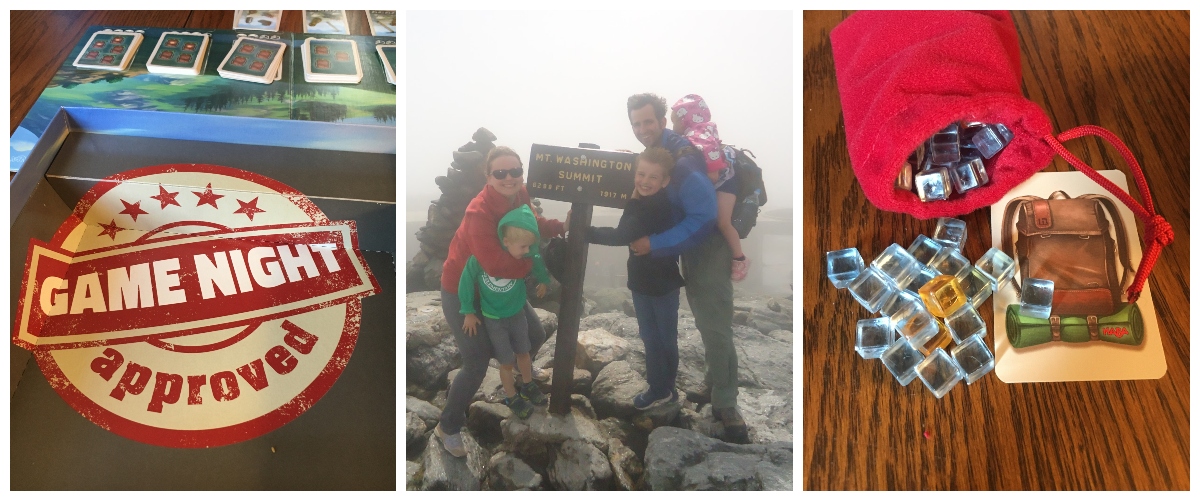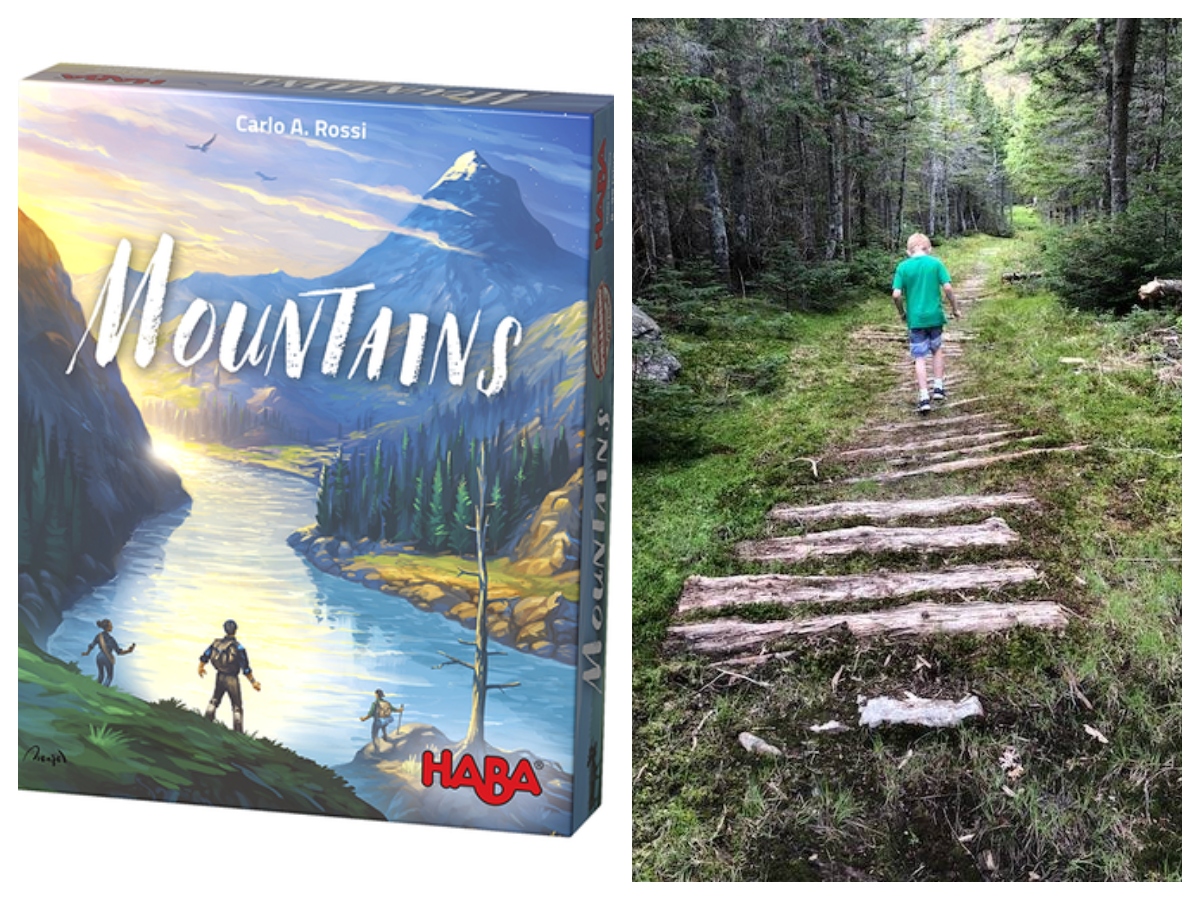It’s a beautiful day and we have decided to go on a hiking adventure. In the foothills of the mountains, we breathe deep of fresh air and pine needles. But wait! What’s this? We’ve forgotten a key item of gear! Can we borrow from a fellow hiker? Is there a supply hut to visit? Will we be able to hike at all today?
These are the questions each player gets to ask while playing Mountains by Haba. We have long been a fan of Haba games in our household. Their pre-school board games are beyond compare and have grown along with our children. While our hiking options have been curtailed a little during the pandemic, we have all been utterly delighted to get into the spirit of adventure with this peaceful, borderline cooperative game.

Components
1 cloth bag
70 blue favor stones
10 yellow favor stones
32 equipment cards
1 stamp pad
1 Summit stamp with case
5 summit books
1 mountain plan board
1 tear-off pad with season sheets
62 hiking cards
The artwork in this game is simple but beautiful, from a watercolor sketch of the mountains to the chalkboard symbols used to designate the rewards of a hike. The game is in fact illustrated by Michael Menzel, who is the illustrator of one of our earliest and favorite games from Haba, Brandon the Brave. The components themselves are skillfully done. While the favor stones are reminiscent of King of Tokyo it is the summit books and season sheets that won my husband’s heart. Each game can be played by two to five players, and each player receives one of the summit books. The books are multi-use, and each time you play you insert a new season sheet. The game comes with a whole pack, but, be still my heart, the center pages of the instruction book are the blueprints for the sheets so you can make them ad infinitum.
How do you set up Mountains?
The mountain plan board should be within easy reach of all players and has six spaces for the hiking cards to be placed according to the level of difficulty, level one being the easiest and level six the hardest. The degree of difficulty is determined by the number of packs on the back of the card. The instructions call them rucksacks, which my English heart loves. Each player receives eight favor stones to start the game. This can be eight blue stones, which is preferable, or three blue stones with one golden stone if you are a snarky twelve-year-old who wants to collect the gold ones even though that is not the object of the game. As well as stones, each player begins with a set number of equipment cards depending on the number of players. These might be the only cards you get for the whole game, and you should not reveal them to anybody. Every potential hiker receives a summit book with a season sheet. The stamp and ink pad should be kept as far away from your most fidgety player as possible.
How do you play Mountains?
Play begins with the person who has most recently climbed the highest mountain. In our house that is always a tie between my husband and our twelve-year-old; he summited Mount Washington in New Hampshire when he was five. There might be some technical disagreements about who climbed higher on the pile of rocks atop the summit.
Each player’s turn begins with the selection of a hike. The fewer rucksacks on the hike card, the easier the hike will be. One rucksack means you will only need one piece of gear and so forth. The hardest hike takes five pieces of gear, two of which are always the same. Completion of easy hikes will earn you favor stones, while more difficult hikes will win you a combination of favor stones and stamps on your season sheet. The five rucksack hike mentioned above gets you five stamps but no favor. The game is won by stamps in the pad, not by favor stones, so as the game progresses you need to bear that in mind when choosing hikes.
After drawing a hiking card, you need to place it face up in front of you and then decide if you want to attempt it. To complete the hike you need all the pieces of equipment. If you do not have the equipment you can still attempt it by using favor stones to borrow equipment from other hikers. Once all the equipment is laid out on the table, you have completed the hike. You then earn the favor stones and/or stamps depicted and return any borrowed equipment.
If you need to borrow many things, you can borrow from multiple people. You have to give each of them the favor stone before you ask the favor. If they have it, they have to share, but if they don’t have it, they get to keep your stone but you don’t get to borrow anything.
If you don’t want to attempt to gather the equipment you can simply pass on the hike. You miss a chance to get stamps, but you do get one blue favor stone for making a wise decision. You can also choose to take a rest day, not turn over a hiking card, and instead receive three blue favor stones from the stockpile.
In our family, everything comes with a story and so we play this game heavy on narration surrounding the camping trip and day hikes. My six-year-old daughter’s first hike was a nighttime hike and she had only packed crampons, which don’t light up, so she needed a lantern. Luckily her dad was along for this trip and was resting that evening, so she gave him a favor stone and asked to borrow his lantern. He had a lantern so she got to borrow it, refusing a fellow hiker is a no-no in this game. At the end of her hike, she regaled him with stories of bats and owls, received three favor stones, and he got his lantern back. Her favorite hike involved two helmets, one of which we determined was for using on her butt—we are playing with a six-, nine-, and twelve-year-old after all.
The storytelling is not part of the game itself, but it is so much fun, and so helpful for their imagination, I would encourage it as a standard house rule, though you may need someone like my husband in your group to get the full effect. If you know someone who has a story for every situation, uses the phrase “to make a long story longer,” or could easily be the subject of many favored memes, then make sure you play with them. The image drawn up of my six-year-old hiking into the night on borrowed boots, holding up two borrowed lanterns, with a borrowed knife between her teeth, almost made her pee her pants.
Special Cards
Each pile contains two special cards that can aid you on your daily hike or on your journey to win the game.
If you turn over a mountain hut depicting a camp store, then you may buy an equipment card from the draw pile. All other players also get to partake in your good fortune, as long as they have the requisite two blue favor stones to exchange. If you turn over a mountain hut depicting a mountain stamp, then you get the option to trade in favor stones for stamps without having to take a hike. Some of these are pricey, but some really aid your goal for shockingly few stones. Drawing one of these cards is a bonus turn. Once everyone has finished trading in stones for equipment or stamps, the player who drew the card gets to draw again and attempt a hike.
How do you win Mountains?
The game ends when, at the end of a turn, two decks of cards with a difficulty rating of three, four, five are completely used up. At this point, you tally up. If you ask my twelve-year-old, there is victory in creating the most grandiose tower out of the most favor stones, but in reality, the person with the most stamps on their season sheet wins.
Should we buy Mountains?
Yes. Just yes.
Usually, when I play a new game with my family I have a list of provisos about who to play this with, when to play, how much adult supervision is needed. But everyone in our family enjoys this game, and we all thoroughly enjoy playing it with each other again and again.
My six-year-old wakes up at 5:30 am every day and every weekend for the past three weeks. The first question after “Is it wake up time?” has been “Can we play Mountains?” This last time, by the time I had stumbled into the bathroom, then into the kitchen to put the kettle on, she had completely set up the game. Season sheets in pads, favor stones counted out, hiking cards arranged appropriately. She just turned six. This is the first game she has ever been so invested in that she has been able and willing to set up all on her own. I was impressed. Then I got coffee.
This was a fantastic game to play with our twelve-year-old and six-year-old together. One still learning how to share well, the other halfway through middle school and needing a daily refresher course in sharing with siblings and being nice to people. The game is designed for players to work together; on the mountain, you have to help a fellow hiker. You can bluff and joke and make light, but at the end of the day, you share resources. Watching my kids do this was absolutely joyous. You are trying to get more stamps to win the game, but at the same time, you are all pulling for each other, lending each other equipment, and having fun on the mountain.
Mountains has a rather lackluster rating on Boardgamegeek.com, one that would usually put me off trying a game. But I find myself with not nearly enough superlatives to talk about how thoroughly we are all enjoying playing this game. I have been looking for a good hiking game for years, to play on rainy days when hiking itself is off the table, and this one really fits the bill. But even if you aren’t a hiker and the theme doesn’t interest you, the mechanics of the game are engaging and fun enough to bring you along for the hike and keep you coming back for more. The game is rated for ages eight and up, but don’t let that fool you. My six-year-old will tell you another story.
GeekMom received this game for review purposes











